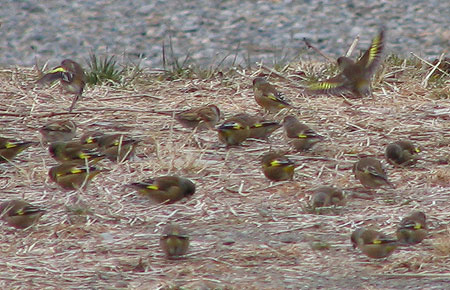A Little Egret and the Greenfinches
I just had the one day off this weekend, but decided to spend a few hours of it birding again, just checking to see what the local area had. The forest park just around the corner was pretty much empty, but the riverbanks delivered as usual. Saw the Widgeon and Teals again, as well as a Cormorant or two. In a small river offshoot, I got a much closer look at a nice Little Egret. It gave me an even closer look when it flew up and rested on a telephone wire:

But the big surprise of the day was a flock of Oriental Greenfinches, feeding in the shallow, muddy ponds along the banks, formed by recent snow. It was hard as heck to get close enough to get decent shots, making me wish for a 20x optical zoom, but I was able to get some fair pictures of them. But I had to sneak up, and when I got too close, they’d fly a bit more down the riverbank, until they decided it was too far, and then they flew back to the original end. I must have followed them back and forth four or five times, till my finders almost froze, snapping away.

Their bodies have a greenish-grey color, but most impressive is the flash of bright yellow on their wings and tails. Here’s a slightly better, closer view of a few:

A better shot still, and a chance to note that the Greenfinches mixed together with local sparrows; take a close look, and you’ll spot a few of the finches’ plainer cousins:

Or a much better view here, with a finch and sparrow caught next to each other in flight:

Now, the value of digital cameras comes in the number of shots you can take without cost. I must have taken a hundred and fifty shots of the Greenfinches, and most were no good. But the benefit of taking so many shots is that you’re bound to get at least one great one–and here it is, a cropped version shown here, of a shot I got of the flock flying past me, in good focus, many with wings beautifully spread:

If you want to see a larger image, here’s one at 1000 pixels wide, and here’s the full-sized original (444 KB).
If I can get myself up early enough tomorrow, I’m going to try to stop by Meiji Shrine–I understand some interesting birds can be found there, and it’s almost right on my way to work anyway.

Luis, your photographs are spectacular!
I found your site because I was looking for some way of identifying 2 birds I found in Jacksonville, Florida. Unfortunately, both were dead on a sidewalk in the middle of the city.They were beautiful little creatures about 5″ or 6″ long.
Both had feathers that were roughly the color of an avocado, I think shading to dark grey. The breast of one was shaded from deep yellow at the throat to pale lemon at the legs. The other’s breast coloring was white with dark or black speckles.
Can you give me an idea what kind of birds they mnight have been?
Margaret:
Sorry, I’m can’t be completely sure from your description, and I’m not really a bird expert or anything. It might be a good idea to look in a field guide for birds, you can find them in bookstores or, I’m sure, libraries. You might also inquire at local pet shops.
The kind of bird you describe could be any of many, many species. Color is only one identifier. Better is the bill (beak). The shape of the bill can be very telling. Is it flat or conical, thick or thin, wedge-shaped, curved, hooked, cross-billed, etc.
Size is sometimes complicated–were the birds 5 or 6 inches from bill to tail, or head to rump? Did it have a small body and a long tail, or vice-versa?
The tail can also be telling–length and shape can be quite different. Then there are smaller markings, such as wing feather striation, lines or patched around the eyes and head, stripes or patches of color on or beneath the wings. Sometimes even very small details can differentiate species.
In general, males tend to be more colorful in the bird world, and the differences between genders can be greater than differences between species at times. And colors can change by season or by age.
Then there are captive birds, which I suspect you may have stumbled upon. Finding a bird dead in a city street may be uncommon enough, but finding two birds? Birds usually go to a reclusive place when they are ready to die. For two to die at the same time, in the same location, on a public avenue, sounds fishy. You may have found two pet birds–possibly imported from the ends of the earth–that died from poor care and were dumped by an uncaring owner.
If I had to guess as to species, however, I’d say it’s most likely you found a pair of greenfinches, not too dissimilar from the ones shown in this post. Some varieties can have yellow breasts.